Other instruments
InSight: a comprehensive geophysical observatory
Besides the SEIS seismometer, InSight has a fully equipped weather station (APSS, for Auxiliary Payload Sensor System) with temperature and wind sensors, as well as three sensors to be installed on Mars for the first time: the HP3 heat flow sensor, a fluxgate magnetometer and an ultrasensitive barometer for detecting infrasound. To crown it all, the telecommunications system will be used to accurately monitor the planet’s rotation and disturbances caused by its liquid core.
The Heat flow and Physical Properties Package—written HP3 and pronounced "HP cubed" — is designed to measure the flow of heat escaping from the interior of the Red Planet. Proposed by the Berlin Institute of Planetary Research (part of DLR, the German Aerospace Centre), HP3 will penetrate the Martian soil to a depth of 5 m using a self-propelled mechanical mole, measuring how temperature varies with depth. Like SEIS, HP3 will be set on the ground by InSight's robotic arm, IDA.
The telluric planets of the solar system that have a solid surface are all warm spheres that are slowly but surely cooling down through contact with the space vacuum. In addition to the thermal energy they acquired when they were formed, most of the internal heat of small planets is produced by the decay of radioactive atoms, mainly thorium and uranium, but also potassium.
As continental drift, volcanic eruptions and earthquakes all demonstrate, the geology of planet Earth is still vigorous despite its great age. Born at the same time, 4.5 billion years ago, Mars' fate has been quite different. On the Red Planet, the plate tectonic mechanism that cracks the rocky crust into shifting plates seems never to have occurred. Although the impressive volcanic cones visible on the Martian surface are evidence of a violent past, no volcanoes are active today: the last lava lakes in the caldera of the great volcanoes appear to be several hundreds of millions years old, with the most recent (and very rare) lava flows dating back less than 10 million years.
Finally, the formerly ubiquitous magnetic field is a mere shadow of its former self. It must have disappeared at least 3 billion years ago, and only traces of it still exist in the oldest crust of the planet. In contrast to Earth, Mars seems to have lost much of its internal heat. Is the planet no more than just a cold sphere, or do its depths still contain reservoirs of near-molten rock, the final trace of a once powerful planetary engine now breathing its last? One of planetary researchers’ top priorities is to determine the energy budget of Mars, which is where HP3 comes in..
Mars in a Minute video series : How Did Mars Get Such Enormous Mountains ? (© JPL-Caltech).
In order to measure the current heat flow from Mars, i.e. the quantity of heat that continues to escape from its surface before disappearing into cold space, InSight carries a novel instrument known as HP3 (pronounced HP cubed). The Heat Flow and Physical Properties Package is actually just a highly sophisticated thermometer. With a mass of approximately 3 kg, HP3 comprises several subsystems:
A metal support structure 36 cm long resting on four legs 10 cm in diameter that encloses the mole, as well as two cables (or “tethers”) coiled up in two compartments. A mole capable of burrowing into the soil. This mole has: An electromechanical hammer device that drills by impact. A tilt meter (STATIL) that reports the mole's deviation from the vertical during drilling and is protected from the unavoidable mechanical shocks due to the percussive mechanism. A heated sleeve (TEM-A) fitted with temperature sensors to determine the soil’s thermal conductivity. A 3-metre-long technical cable that connects the instrument to the electronics unit, coiled comfortably in the lander’s remote warm enclosure box (RWEB). A 5-metre-long scientific cable that connects the mole to the support structure, provides electrical power and carries data. Fourteen passive temperature sensors are also soldered at regular intervals along the cable. Finally, markers are positioned on either side of the cable to monitor the penetration depth using an optoelectronic system (Tether Length Monitor). At 35 mm, the scientific tether is slightly wider than the mole's borehole to allow the temperature sensors to make good contact with the walls and hence with the soil. An electronics unit inside the lander’s RWEB, a compartment isolated from the rigours of the Martian climate.
Once InSight has landed on Elysium Planitia, the HP3 instrument—initially attached to the lander’s deck—will be lifted up by the robotic arm (IDA) and then set down on the surface at a location chosen specifically by the scientists as suitable for drilling. During deployment, the technical tether will unwind behind the instrument, which will therefore remain connected to the InSight lander. The process of placing HP3 on the surface of Mars should start on sol (Martian day) 44 after landing and extend to sol 58. The mole drilling operation per se will then be able to start.
The maximum penetration depth for HP3 is five metres. Theoretically, it should be possible to reach this depth in a few hours, though in reality the engineers and scientists involved will be working step by step, advancing with great care so as to minimize as far as possible any risks during the crucial drilling phase, thereby maximizing the collection of scientific data.
The mole will be programmed to penetrate the Martian soil to a depth of 50 cm before stopping. There will then be pause of 48 hours to allow the frictional heat between the mole and the ground to dissipate. Thermal conductivity measurements will then be made over the course of a day before restarting the drilling process. At this pace, under ideal conditions and provided all goes according to plan, the 5-metre depth limit should normally be reached by the end of a month of operation.
Of course, there is nothing to guarantee that the mole will be able to penetrate that far below the surface of Mars. As anybody who has tried to erect a tent by hammering tent pegs into the ground will know, the soil may prove to be a real challenge in itself. The planetary scientists chose the landing site for the InSight probe on the vast Elysium Planitia with great care. High resolution imagery, together with measurements of thermal inertia (the ability of a surface to cool down faster or slower) and radar soundings led to the selection of a region where the surface is not too loose (to avoid the probe and its instruments sinking too deep) or too hard (which would prevent the HP3 from penetrating the ground). If however (for whatever reason), the progress of the mole should become very difficult, drilling will be stopped.
Similar to the mole on Britain’s small Beagle 2 capsule, lost during Christmas 2003, the mole is undoubtedly the heart of the HP3 instrument. All the scientific results of this experiment depend on its ability to drill through the Martian subsoil. The greater the depth achieved by the mole, the shorter the measurement time required to fulfil NASA's scientific objectives.
To drive itself into the ground, the HP3 mole (which resembles the pointed end of a ballpoint pen) will not be using a rotating auger but an ingenious hammering mechanism. A metal slug is propelled forward by the magnetic field generated by a coil, then restored to its striking position by a spring, ready to start the cycle over again. At each forward impulse the mole will force its tip a little further into the Martian regolith. The vibration associated with this drilling process will naturally be carefully measured by the SEIS seismometer, which will already be listening out.
In addition to its hammer mechanism, the HP3 mole has a tilt meter (STATIL) that detects changes in direction relative to the horizontal. Combined with the Tether Length Monitor (TLM), a device that measures the length of the cable as it unwinds, the tilt meter can determine the absolute depth of the mole, a piece of information essential for establishing the soil temperature profiles. The TLM is an optoelectronic sensor that counts the passage of markers located on each side of the scientific cable. Finally, the mole is encased by a heated sleeve (TEM-A) that has its own temperature sensors.
For the sake of completeness, it is worth mentioning that the HP3 experiment includes a radiometer mounted underneath the lander platform and facing towards a part of the surface unobstructed by the instruments on the ground or in the probe's shadow. Contrary to what its name might imply, the role of this sensor is not to measure the radiation striking the Martian crust but simply to measure the heat flow (infrared radiation) emanating from the surface and defining its temperature (specialists refer to the “brightness temperature”).
The HP3 experiment will take the first measurements of heat flow on a planet other than Earth. For the moment, the only extraterrestrial heat flow data we have were obtained on the Moon during the Apollo 15 and 17 missions (the American astronauts used manual augers to bore into the surface and place temperature probes in the subsoil).
By studying the ease with which the wave of heat emanating from the heated sleeve propagates into the Martian surface, scientists will be able to determine the thermal conductivity of the regolith, i.e. the ability of the Martian soil to conduct heat. It should be possible to measure the heat flow accurately even if the soil conductivity turns out to be very low. The daily attenuation of the diurnal temperature wave will provide HP3 with another means of characterizing the ground’s thermal conductivity.
The variation of temperature with depth, i.e. the thermal gradient, will be another important parameter for HP3 to determine. The scientific tether that the mole trails behind it as it makes its way down through the regolith will provide power and transmit data. As we have seen, this tether is fitted with a dozen or so temperature sensors located at regular 35 cm intervals. These sensors will be able to provide a changing profile of temperature versus depth.
The depth of penetration therefore has to be measured accurately, given that the mole may well be unable to descend perfectly vertically, and it is highly probable that it starts to skew at some point in time. The tilt meter fitted to the mole will allow its orientation in the subsoil to be measured at all times, but this is just one step in determining the depth, which can only be known precisely by using the Tether Length Monitor (TLM). The purpose of this optoelectronic sensor will be to count the passage of markers attached on either side of the scientific tether as it gradually unwinds. Knowing the tilt, the depth reached by the mole can be calculated unambiguously from the length of cable behind it.
The thermal measurements made by HP3 will establish the heat flow, i.e. the ease with which Mars' residual heat leaves the planet to be dissipated in the cold dark depths of space. Theoreticians estimate that the power dissipated into space by the Martian surface should be between 17 and 29 mW/m2 (compared to Earth’s mean heat flow of 87 mW/m2). Using this crucial piece of information, planetary scientists will be able to probe the depths of the Martian globe indirectly. Hence they will be able to estimate the temperature of the Martian mantle and place limits on the abundance of thermogenic radioactive elements that the Red Planet might still possess deep within.
Although the proper execution of the experiment depends heavily on the mole's ability to make its way down through the Martian soil, the measurements made by HP3 will nevertheless always suffer interference from a number of unavoidable phenomena that will have to be measured and then removed from the data. One of the most obvious of these is the heating of the ground at daybreak, followed by its cooling overnight. Though they will affect the data collected by HP3, other temperature variations are harder to quantify, such as the annual temperature variations due to the climate or those related to variations in the inclination of the planet's axis of rotation (variations in obliquity, though these are less at the equator).
If the HP3 mole reaches a depth of 5 m as expected, it will register the disturbance in the surface temperatures generated by the shadows from the lander and the SEIS instrument’s WTS only after one year.
In addition to the thermal information, the soil’s greater or lesser resistance to the motion of the mole will provide important information on its physical properties. Many unknowns remain as to the characteristics of the Martian soil, whether on the surface or, more especially, in the depths yet to be explored.
Given that the planet Mars is a priority target for traces of life, past or present, space agencies are obliged to take a great number of precautions to avoid any contamination with terrestrial microorganisms, whose astonishing ability to withstand the hellish rigours of spaceflight are well proven. This is the domain of planetary protection. Desiccated, exposed to harmful ultraviolet radiation from the sun and to cosmic rays, and loaded with toxic compounds such as perchlorates, the Martian surface is hostile to life by definition, or at least as far as we know. The depths of the planet might seem more benign in comparison, and it is precisely these depths that HP3 is intended to explore, albeit down to only a few metres.
NASA has therefore listed a number of prerequisites that HP3 must satisfy in order to reduce the risk of contaminating the subsoil of the Red Planet as far as possible. Lying at the equator, the Elysium Planitia has a dry regolith completely free of ice. If such ice is indeed present in the form of beads or spindles, it is at depths inaccessible to the HP3 mole (though in other regions of the planet, such as at the higher latitudes, white ice may be found just a few centimetres below the surface).
Through its very operation, the HP3 mole will create transient waves of heat whether during drilling or obtaining active conductivity measurements with the TEM-A heated sleeve. These temperature rises should vary between +10°C and +50°C, causing the ground (initially at roughly -55°C) to reach a temperature of around 0°C.
Since there is no ice, HP3 will be unable to create microscopic pockets of liquid water to fill the pores of the soil. However, the Martian soil at the landing site could contain hydrated minerals, i.e. crystalline structures containing molecules of water. One of the rules of planetary protection stipulates that any water potentially liberated by HP3 during drilling or active measurement of thermal conductivity must displace no particle greater than or equal to 50 nm (a nanometre is 10-9 m). To meet this constraint, engineers determined the number of molecular layers liberated by heating the mole and how they varied with time. These short-lived aqueous films tend to spread out in all directions through capillary action, but their thickness would not be enough to displace soil particles as small as 50 nm. HP3 was therefore given the green light by planetary protection officials.
The mole does not have its own source of energy, but is supplied with electrical power through the scientific cable. There is therefore no chance that it could break free to penetrate the depths of the soil all by itself. However, the planetary protection protocols to be applied during the HP3 experiment try to cover all cases, including that involving a partial or total breakage of the cable to which the mole is attached. So, if during the drilling process the scientific cable connecting the mole to its compartment should break, power to the mole will be automatically cut off and drilling would cease immediately.
The InSight probe has a complete instrument package for characterizing the atmosphere as well as the environmental electromagnetic noise in which the ultrasensitive SEIS seismometer is expected to function. The Auxiliary Payload Sensor System (APSS) includes a magnetometer developed by the University of California, Los Angeles.
Called the InSight FluxGate (IFG), this magnetometer will be the first to record magnetic data directly on the surface of Mars. It has a sensitivity of 0.1 nT (nanotesla).
Like all self-respecting geophysical stations, InSight comes with a complete weather station, or Auxiliary Payload Sensor System (APSS) whose primary purpose is to help characterize the influence of the landing site on the measurements made by the SEIS seismometer.
Seismometers are very sensitive instruments, capable of recording with great precision all sorts of phenomena that may have nothing to do with ground tremors and the propagation of seismic waves. SEIS is no exception, and like the seismometer on the Viking Mars probes before it, the slightest gust of wind or variation in temperature will disturb it.
The environment of the landing site will therefore be characterized in as much detail as possible by APSS, a sophisticated weather station bristling with temperature sensors, wind sensors and anemometers providing information about wind speed and direction, and finally, an ultrasensitive pressure sensor.
The sensors used for TWINS (Temperature and Wind Sensors for InSight) are very similar to the REMS (Rover Environmental Monitoring Station) sensors used on the Curiosity rover, which has been trundling around the Gale impact crater since 2012. One of the sensors is mounted on the deck while the second is attached to the Instrument Deployment Arm (IDA) behind the Instrument Deployment Camera (IDC). These will record the air temperature, wind speed and direction twice per second throughout the mission, i.e. one Martian year (which is two Earth years).
An ultrasensitive pressure sensor capable of reacting to pressure variations in the order of a dozen µPa (i.e. 10-7 mbar) is mounted on the lander's deck underneath the WTS (the shield being lifted up by the robotic arm so as to be placed over the SEIS instrument once it is on the surface).
The various subsystems of the APSS weather station (temperature sensors, wind vane, anemometer, barometer and magnetometer) will play a crucial part in interpreting the data provided by the SEIS seismometer. SEIS will certainly be influenced by interference from the incessant activity of the Martian atmosphere; the slightest gust of wind will transfer energy to the ground that will then be recorded by the seismometer. Similarly, the continuous and tiny changes in air pressure will translate as a very subtle drumming of the surface.
At any given instant and at any given location, the effect of the constantly fluctuating pressure field is to press or release the ground (loading and unloading respectively), as if a multitude of invisible fingers were drumming on the Martian surface like a computer keyboard, deforming the ground. Using the ultrasensitive pressure sensor in the APSS, these pressure variations can be measured and then removed from the signal acquired by the SEIS seismometer. Similarly, the variations in temperature recorded by the temperature sensors will be subtracted (decorrelated) from the data provided by the seismometer.
Besides its supporting role in acquiring seismic data, the APSS weather station will naturally also help to improve our understanding of Mars' current weather and climate. In addition to studying the wind, InSight will also investigate high-altitude clouds, fog on the surface, dust devils or atmospheric opacity due to suspended dust particles, for example. On the same subject, the camera on the robotic arm and the solar arrays (as a result of the drop in power due to the deposition of a layer of dust) will also make their contribution.
The RISE geodesic experiment does not require any specific instrument. It relies on the InSight lander's telecommunications system, which allows it to precisely measure variations in distance between the spacecraft and Earth due to the rotation of the planet Mars about its axis.
Like all the planets in the solar system, Mars turns like a top around an axis of rotation passing through the north and south poles. The Red Planet makes a complete rotation every 24 hours and 37 minutes, with its axis inclined at roughly 25° to its orbital plane around the Sun. Its rotation and the inclination of its axis are therefore quite similar to those of Earth, which makes one rotation every 24 hours around an axis inclined at just over 23°. Other planets in the solar system depart from these values and show some astonishing features: Venus rotates very slowly (116 days) in the opposite direction, while Uranus has an axis of rotation that is practically parallel to the orbital plane whereby the poles are inclined towards the Sun, while the equator is at 90°!
The rotation of planets is well known, and even though there may be a few special cases that are poorly explained (like Venus and Uranus), it might be tempting to assume that the phenomenon is rather banal. Nevertheless, the continuous accurate study of how Mars rotates about its axis has a major advantage, namely that of discovering more about the depths of this celestial body.
Planets in the solar system, such as Mars and Earth, are not necessarily uniform rocky spheres like cosmic billiard balls. Their interiors are structured in the form of layers of different thicknesses and composition. Moving from the surface towards the centre, the three most important layers are the crust, the mantle and finally the metal core.
If we take two spheres, one completely homogeneous, the other with a structure in the form of layers of differing densities, and we then make them spin like tops, we quickly observe that the rotational motions are not the same. The manner in which the material is distributed throughout the volume of the two spheres (what physicists call the moment of inertia) is different, and this has an effect on how objects rotate. An experiment can easily be carried out using a hard-boiled egg and a raw egg. Once set spinning, the two objects will not behave in the same way in space since the structure of the raw egg, which combines both liquid and solid, is different from that of the hard-boiled egg, which is entirely solid.
A detailed study of the rotational motion of a planet about its axis shows that over the course of time the position of the axis varies in space. The axis describes a circle about a fixed vertical position: this is precession. For planet Earth, the axis of rotation makes a complete turn in the heavens every 25,770 years on average. This terrestrial precession, known as precession of the equinoxes, is directly linked to significant climatic changes. The celestial drift of Mars' axis of rotation is much slower, only making a complete turn in 165,000 years.
If we observe in fine detail the path traced by the axis of rotation of Earth or Mars, we see that neither axis describes a perfect circle, but oscillates regularly about a central position. These very slight oscillations define nutation: Earth requires 18.6 years to complete one of these small oscillations, as against less than one Martian year (two Earth years) for the Red Planet.
By very finely characterizing the rotational parameters of Mars about its axis (rotational period, values of precession and nutation), geophysicists will be able to obtain a more accurate idea of its interior structure. InSight has therefore been fitted with two medium-gain antennas attached to its deck that look a bit like splayed-out yoghurt pots. These antennas establish direct radio communication between Earth and Mars in X-band, bypassing the relay satellites in orbit around the Red Planet (the downside is that the data rate is lower).
In addition to providing the capability of communicating directly with InSight, the radio signal emitted by the medium-gain antennas can be used to measure the distance between Earth and Mars remarkably accurately (to roughly 10 cm) through a Doppler technique. In terms of listening time, InSight needs simply to be monitored for at least 2 hours per week for one Earth year using the 34 m diameter antennas of NASA's deep space network (DSN).
If the distance should change between a radio transmitter and receiver, the frequency of the radio signal will do the same. Sitting on the Martian equator and being moved around despite itself by the planet’s rotation, InSight’s distance from the Earth will be constantly changing. By following these changes in the distance between Earth and Mars, RISE will provide detailed information on the way in which the planet turns on its axis and on changes in direction of its rotational axis over the course of time (precession and nutation).
In turn, geophysicists will be able to deduce what is hidden out of sight below the surface, i.e. the nature and distribution of mass within the planetary sphere (moment of inertia). It will thus be possible to estimate not only the size and density (and hence the mineralogical composition) of the core, but also the density of the mantle. Precession alone will provide information on the radius and density of the core, but these two parameters are linked, one changing with the other. By studying the nutation, the radius of the core can be separated from its density (the two measurements becoming independent of one another). In particular, RISE should be able to reduce the current uncertainty surrounding the size of the core by a factor of ten.
InSight is not the first probe to have measured the rotation of the planet Mars. Similar experiments were carried out in 1976 by the Viking probes, and then 20 years later in 1997 by Pathfinder. A measurement campaign was also carried out in 2011 when the Opportunity rover was in hibernation. These first data were sufficient to place limits on the size of Mars' metal core. Twenty years after Pathfinder, InSight will take up the baton to refine our understanding of Mars' internal structure. The precession measurements will be ten times better than those made by the Viking probes, and the duration of the observations will be extended, hence improving accuracy.
A penetrator for measuring heat flow
 HP3 with, from left to right, the penetrator, the main deployable chamber and finally the technical cable (© DLR/HP3 team).
HP3 with, from left to right, the penetrator, the main deployable chamber and finally the technical cable (© DLR/HP3 team).
A cooling planet
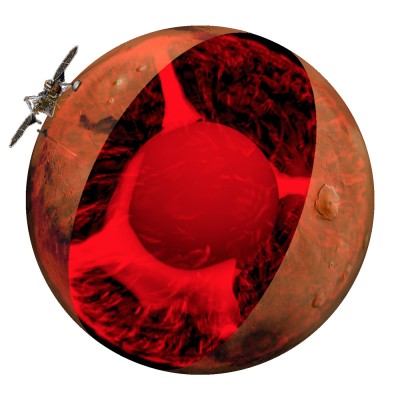 To assist in the interpretation of HP 3 data, numerical 3-D simulations of Mars cooling are performed on Earth (© Ana Plesa / DLR).
To assist in the interpretation of HP 3 data, numerical 3-D simulations of Mars cooling are performed on Earth (© Ana Plesa / DLR).
HP3
 The mole for the HP3 experiment (© Max Planck Institute/DLR)
The mole for the HP3 experiment (© Max Planck Institute/DLR)
Deployment
 The HP3 instrument will be placed on the ground by InSight's robotic arm once the SEIS instrument has been correctly deployed. The mole, trailing a ribbon cable fitted with temperature sensors behind it, will bury down a maximum of 5 m (© DLR/HP3 Team).
The HP3 instrument will be placed on the ground by InSight's robotic arm once the SEIS instrument has been correctly deployed. The mole, trailing a ribbon cable fitted with temperature sensors behind it, will bury down a maximum of 5 m (© DLR/HP3 Team).
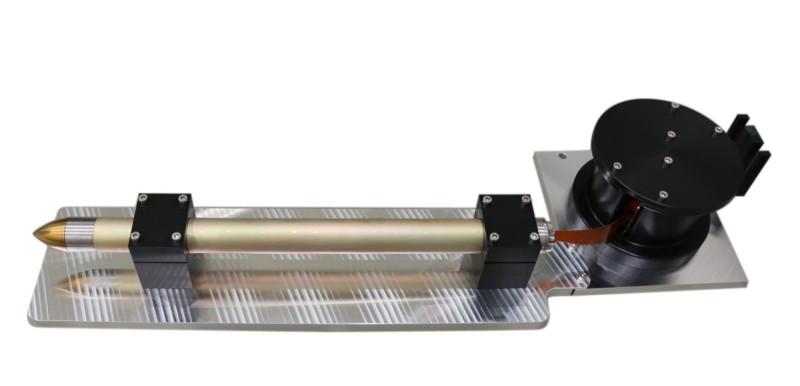 The HP3 mole is approximately 16 cm long (© DLR/HP3 Team).
The HP3 mole is approximately 16 cm long (© DLR/HP3 Team).
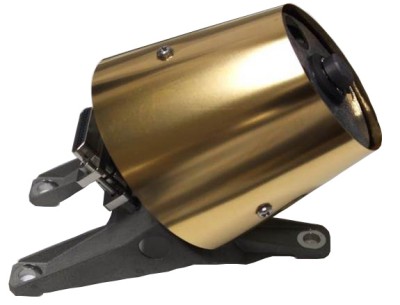 The radiometer on the HP3 experiment (© NASA).
The radiometer on the HP3 experiment (© NASA).
First measurements of heat flow since the Apollo lunar missions
Planetary protection
Last updated: 28 October 2016
 The fluxgate magnetometer (© UCLA).
The fluxgate magnetometer (© UCLA).
The first magnetometer on the surface of Mars
Last updated: 28 October 2016
A complete weather station
 The TWINS sensors from InSight's weather station (© NASA).
The TWINS sensors from InSight's weather station (© NASA).
TWINS
Pressure sensor
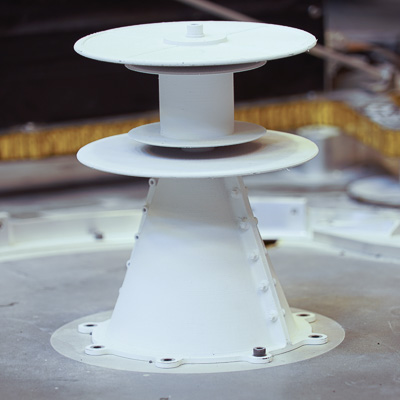 The air inlet of the ultrasensitive pressure sensor of the APSS weather station located on the deck of the InSight lander (© NASA/JPL-Caltech/IPGP/Philippe Labrot).
The air inlet of the ultrasensitive pressure sensor of the APSS weather station located on the deck of the InSight lander (© NASA/JPL-Caltech/IPGP/Philippe Labrot).
Atmospheric disturbances
Dernière mise à jour : 2 January 2019
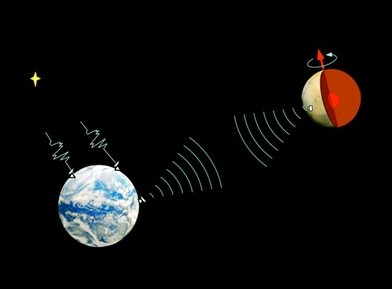 RISE, InSight's geodesy experiment, exploits the spacecraft’s radio communications system with Earth (© NASA).
RISE, InSight's geodesy experiment, exploits the spacecraft’s radio communications system with Earth (© NASA).
Investigating the rotation of Mars to deduce its interior structure
Precession and nutation
 Turning on its axis like a top, Mars forces its axis of rotation to describe a circle about some arbitrary position. This is the phenomenon of precession. Superimposed on the circle itself are small oscillations, a phenomenon known as nutation (© IPGP/David Ducros).
Turning on its axis like a top, Mars forces its axis of rotation to describe a circle about some arbitrary position. This is the phenomenon of precession. Superimposed on the circle itself are small oscillations, a phenomenon known as nutation (© IPGP/David Ducros).
Last updated: 28 October 2016





